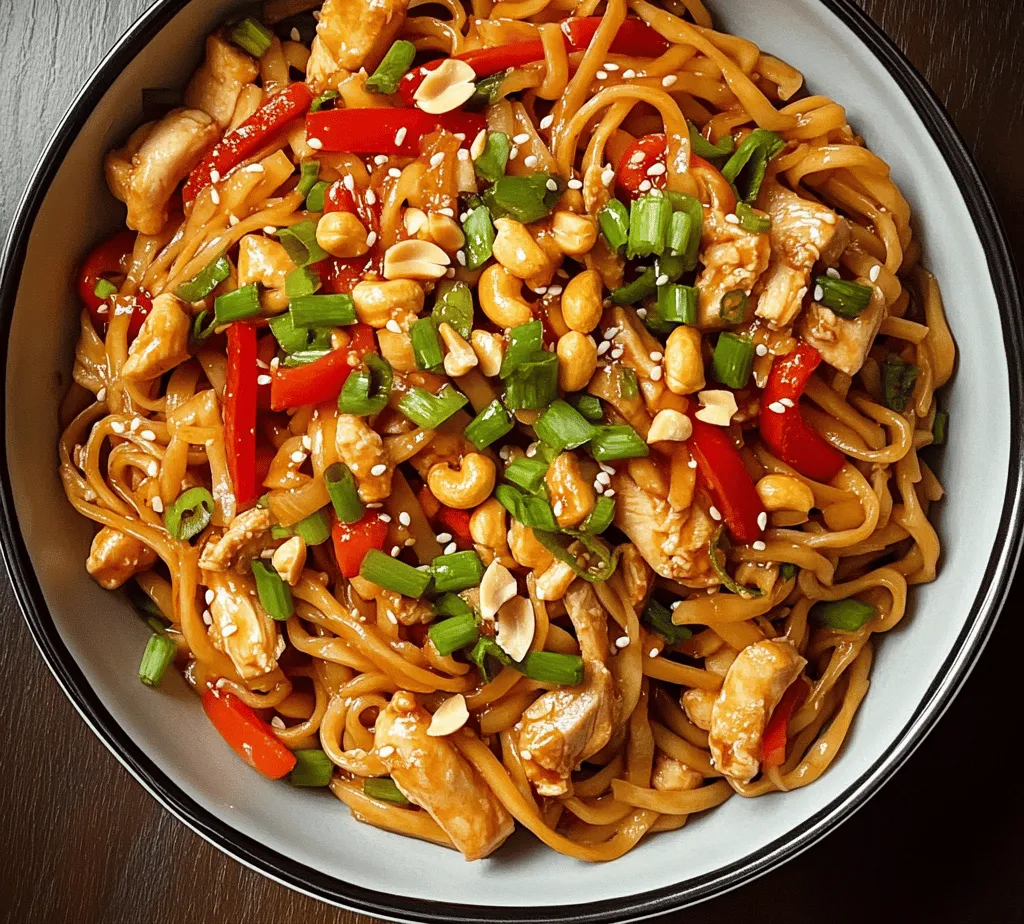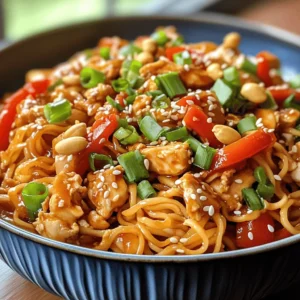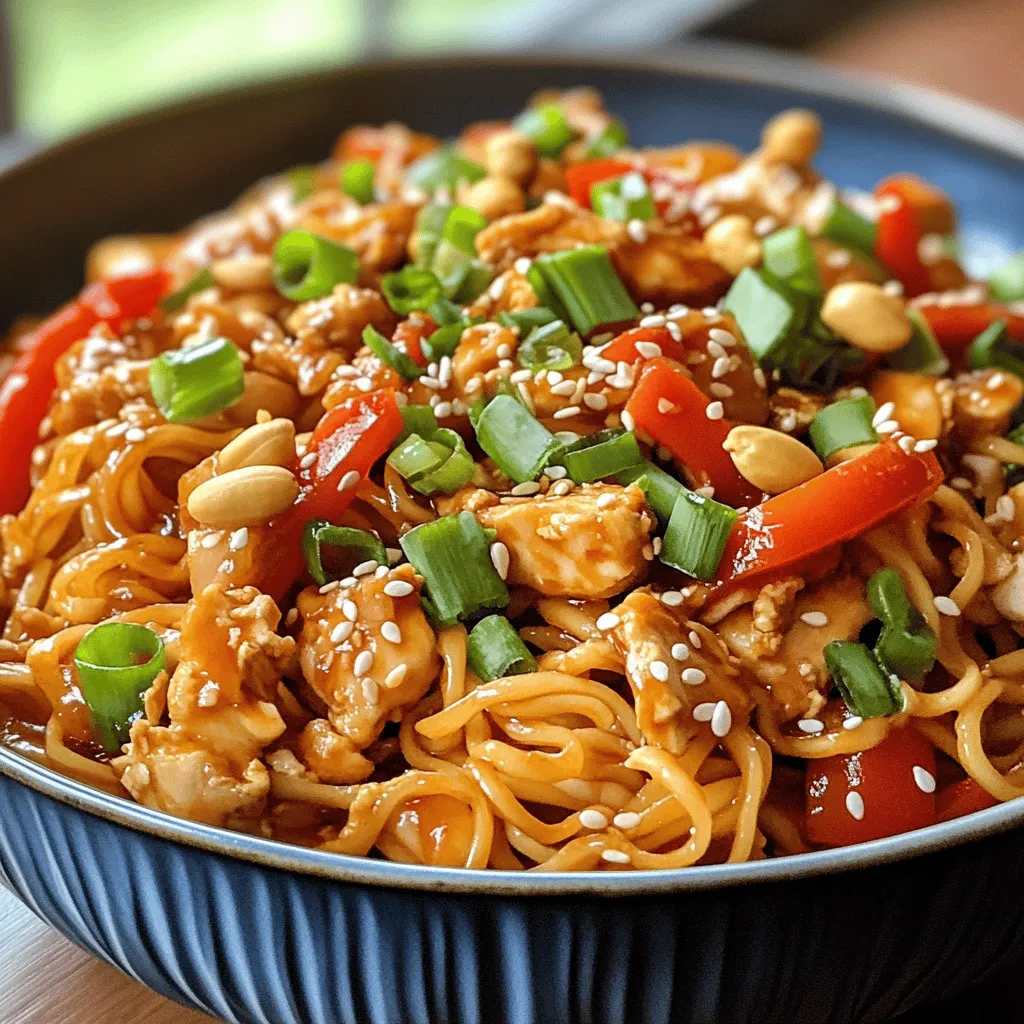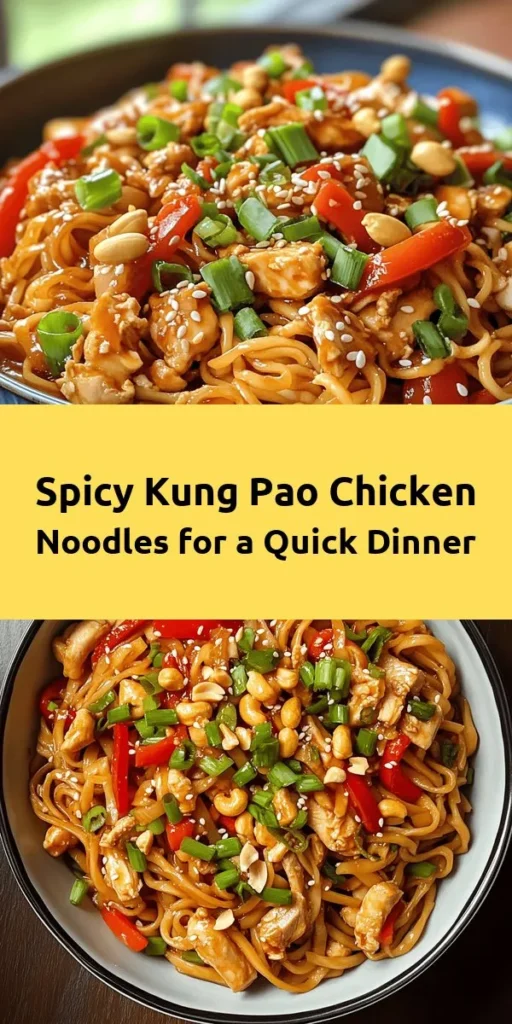Introduction
Kung Pao Chicken Noodles have become a beloved dish in the realm of Chinese cuisine, capturing the hearts and taste buds of food enthusiasts around the world. This delightful recipe combines the classic elements of Kung Pao Chicken—a dish renowned for its bold flavors—with the comforting, hearty texture of noodles. The result is a mouthwatering meal that brings together savory, spicy, and nutty notes in every bite.
Originating from the Sichuan province of China, Kung Pao Chicken has a rich history that dates back to the late Qing Dynasty. Initially prepared for the governor of Sichuan, Ding Baozhen, it has since evolved into a staple in Chinese restaurants globally. The dish’s significance extends beyond just its taste; it embodies the artistry of Chinese cooking, showcasing the balance of flavors and the skillful use of various ingredients that define this culinary tradition.
In this article, you will discover not only the recipe for Kung Pao Chicken Noodles but also the depth of flavors that make it a must-try dish. Expect to learn about the key ingredients that contribute to its distinctive taste, the cultural importance of Kung Pao Chicken, and a detailed guide to preparing this exquisite dish.
Understanding Kung Pao Chicken Noodles
Kung Pao Chicken Noodles present an enticing flavor profile that is both savory and spicy, with a delightful nuttiness that elevates the overall dish. The combination of tender chicken, fresh vegetables, and the bite of peanuts creates a harmonious blend that is satisfying and addictive. The balance of flavors is what sets this dish apart, making it a favorite among those who love bold and vibrant tastes.
At the heart of Kung Pao Chicken Noodles are several key ingredients, each contributing its unique character to the dish. The chicken, typically cut into bite-sized pieces, is marinated and stir-fried to perfection, allowing it to absorb the flavors of the sauces. Bell peppers and onions add sweetness and crunch, while garlic and ginger infuse the dish with aromatic undertones. Peanuts not only provide a contrasting texture but also enhance the nutty flavor that is quintessential to Kung Pao dishes.
Culturally, Kung Pao Chicken holds a special place in Chinese cooking, celebrated for its rich flavors and versatility. This dish has transcended its humble beginnings to become a symbol of Sichuan cuisine, often representing the intricate balance of heat, sweet, and umami that defines Asian cooking. It is not merely a meal; it is an experience, one that invites diners to explore the depths of flavor and the history behind each ingredient.
Ingredients Breakdown
Creating the perfect bowl of Kung Pao Chicken Noodles requires a thoughtful selection of ingredients. Here’s a detailed breakdown of what you will need:
Egg Noodles
Egg noodles are the foundation of this dish, providing a chewy texture that complements the other ingredients. They are made with wheat flour and eggs, which give them their signature richness. When selecting egg noodles, look for fresh varieties if possible, as they tend to have a better texture and flavor compared to dried ones. You can also use other types of noodles, such as lo mein or rice noodles, depending on your preference.
Chicken Thighs
For this recipe, chicken thighs are the preferred cut of meat. Thighs are more flavorful and tender compared to chicken breasts, thanks to their higher fat content. This makes them less likely to dry out during cooking, ensuring that each bite remains juicy and succulent. When preparing your chicken, cut it into uniform pieces to promote even cooking and allow for better absorption of flavors.
Vegetables
A colorful medley of vegetables enhances both the taste and presentation of Kung Pao Chicken Noodles.
– Bell Peppers: These add a crisp texture and a hint of sweetness that balances the dish’s spice.
– Onions: Sautéed onions contribute a savory depth and aromatic quality to the dish.
– Garlic: Freshly minced garlic brings a pungent kick that is essential to many Asian dishes.
– Ginger: This root adds warmth and a hint of sweetness that harmonizes with the other flavors.
Together, these vegetables not only enhance the dish’s flavor but also provide a satisfying crunch that contrasts beautifully with the tender chicken and noodles.
Peanuts
Peanuts are a vital ingredient in Kung Pao Chicken Noodles, providing a crunchy texture and a nutty flavor. They are typically roasted or fried before being added to the dish, enhancing their depth of flavor. If you prefer a spicier kick, you can also opt for spicy peanuts or add a sprinkle of crushed peanuts as a garnish before serving.
Sauces
The sauces used in Kung Pao Chicken Noodles are crucial for achieving the perfect balance of flavors:
– Soy Sauce: This is the base of the dish, offering savory umami notes that tie all the ingredients together.
– Rice Vinegar: This adds a touch of acidity, cutting through the richness of the chicken and peanuts while enhancing the overall flavor.
– Hoisin Sauce: Known for its sweet and tangy profile, hoisin sauce adds depth and complexity to the dish.
Optional Ingredients
For those who enjoy a bit of heat, consider incorporating Sichuan peppercorns and chili paste. Sichuan peppercorns provide a unique numbing spice that is characteristic of many Sichuan dishes, while chili paste allows you to adjust the spice level to your personal preference.
Preparation Steps
Now that you have a thorough understanding of the ingredients, let’s delve into the preparation steps for crafting your own Kung Pao Chicken Noodles.
Step 1: Marinate the Chicken
Begin by marinating the chicken thighs in a mixture of soy sauce, rice vinegar, and a dash of cornstarch. This will not only infuse the chicken with flavor but also create a velvety texture once cooked. Allow the chicken to marinate for at least 20-30 minutes to ensure that it absorbs the flavors.
Step 2: Cook the Noodles
While the chicken marinates, bring a pot of water to a boil and cook the egg noodles according to the package instructions. Aim for al dente texture, as the noodles will continue to cook when combined with the rest of the ingredients. Once cooked, drain the noodles and rinse them under cold water to stop the cooking process. Drizzle a little sesame oil to prevent them from sticking together.
Step 3: Sauté the Vegetables
In a wok or large skillet, heat a tablespoon of oil over medium-high heat. Add the chopped onions and bell peppers, sautéing them until they begin to soften and caramelize. This should take about 3-4 minutes. Next, add the minced garlic and ginger, stirring for an additional minute until fragrant.
Step 4: Cook the Chicken
Increase the heat to high and push the vegetables to the side of the wok. Add the marinated chicken to the center, allowing it to sear without stirring for a couple of minutes. This will help achieve a nice golden-brown color. Once the chicken is browned, stir everything together, ensuring the chicken is cooked through and no longer pink.
Step 5: Combine Ingredients
Once the chicken is cooked, add the cooked noodles to the wok along with the hoisin sauce and any additional seasonings you desire. Toss everything together, allowing the noodles to soak up the sauce and the flavors of the chicken and vegetables.
Step 6: Add Peanuts and Garnish
Finally, fold in the roasted peanuts, mixing them gently to distribute evenly throughout the dish. Garnish with chopped green onions or cilantro for a fresh finish.
This step-by-step guide outlines the initial process of preparing Kung Pao Chicken Noodles, ensuring each ingredient shines and comes together for a delightful dining experience. As you continue with the recipe, you will discover even more ways to enhance the flavors and presentation of this iconic dish.

Marinating the Chicken
Marinating plays a crucial role in achieving flavor depth in your Kung Pao Chicken Noodles. It allows the chicken to absorb the marinade’s seasonings, enhancing its taste and tenderness. For this recipe, a marinade typically consists of soy sauce, rice wine, cornstarch, and a hint of sesame oil.
The recommended marinating time is at least 30 minutes, but if you have the time, allowing the chicken to marinate for 1 to 2 hours in the refrigerator will yield even better results. This not only infuses the chicken with flavor but also helps to tenderize it, making it juicier and more enjoyable.
Stir-Frying Techniques
Stir-frying is an art that, when mastered, results in perfectly cooked ingredients with ideal textures. For Kung Pao Chicken Noodles, the goal is to achieve a balance between tender, cooked chicken and crisp, vibrant vegetables.
1. Preheat the Wok or Pan: Start with a well-heated wok or large skillet. A hot surface ensures that the chicken sears rather than stews, helping to lock in moisture.
2. Cook in Batches: To prevent overcrowding, stir-fry the chicken in small batches. This ensures each piece gets adequate heat and develops a lovely golden-brown crust.
3. Add Vegetables: After the chicken is cooked, remove it from the pan and set it aside. Add your vegetables next, starting with the ones that take longer to cook, such as bell peppers and carrots. Stir-fry these for a couple of minutes until they are vibrant but still crisp.
4. Combine: Finally, return the chicken to the pan along with the cooked noodles and sauce. Toss everything together, ensuring that the sauce coats each ingredient evenly. This step not only combines the flavors but also allows the starch from the noodles to thicken the sauce slightly, creating a perfect consistency.
Flavor Enhancements
To elevate your Kung Pao Chicken Noodles, consider experimenting with optional ingredients and variations that complement the dish beautifully.
– Adjusting Heat Levels: If you prefer a spicier kick, chili paste or additional crushed red pepper flakes can be added during the stir-frying process. Start with a small amount and gradually increase to your taste.
– Alternative Proteins: If you’re looking to switch things up, tofu or shrimp can be excellent alternatives to chicken. Tofu absorbs flavors well and provides a satisfying texture, making it a great plant-based option. For shrimp, ensure they are cooked just until they turn pink and opaque to avoid overcooking.
– Vegetarian Adaptations: For a fully vegetarian or vegan version, replace chicken with plant-based proteins like tempeh or seitan. These alternatives can also be marinated similarly to chicken, enhancing their flavor profile.
Serving Suggestions
Presentation is key when serving Kung Pao Chicken Noodles. Here are some tips to make your dish visually appealing and enjoyable:
– Plating Techniques: Use a large, shallow bowl or plate to serve the noodles. Twirling the noodles into a nest-like shape adds height and intrigue to your presentation. Arrange the chicken and vegetables artfully atop the noodles.
– Complementary Side Dishes: Pair your Kung Pao Chicken Noodles with a refreshing side of cucumber salad or steamed edamame. These sides not only provide a contrast in textures but also balance the dish’s robust flavors.
– Garnishing: Finish your dish with a sprinkle of sesame seeds and sliced green onions. Not only do these garnishes add a burst of color, but they also provide a fresh crunch that enhances each bite.
Nutritional Information
Kung Pao Chicken Noodles not only tantalize the taste buds but also offer a range of nutritional benefits. Here’s a closer look at the nutritional profile:
– Caloric Breakdown: A typical serving of Kung Pao Chicken Noodles contains around 500-600 calories, depending on portion size and ingredients used. This includes the protein from chicken, the carbohydrates from noodles, and healthy fats from any oils used in cooking.
– Protein and Vitamins: Chicken is an excellent source of lean protein, essential for muscle repair and growth. The vegetables add fiber, vitamins A and C, and a variety of minerals, contributing to overall health. The peanuts in the dish provide healthy fats and additional protein.
– Dietary Considerations: For those with gluten sensitivities, using gluten-free soy sauce and noodles can easily make this dish gluten-free. Additionally, you can modify other ingredients to accommodate allergies, ensuring a safe and delicious meal for everyone.
Conclusion
Kung Pao Chicken Noodles is not just a meal; it’s a versatile dish that brings a delightful explosion of flavors to the table. Whether you choose to prepare it as a quick weeknight dinner or as an impressive dish for guests, the balance of savory, spicy, and nutty elements makes it universally appealing.
Trying your hand at this recipe at home opens the door to exploring the vibrant world of Asian cuisine, enhancing your culinary skills, and enjoying a homemade meal that satisfies your cravings. Cooking is a joyful journey of discovery, and with dishes like Kung Pao Chicken Noodles, you can share that joy with family and friends. Embrace the flavors, experiment with variations, and savor the delightful experience of creating this beloved dish.



